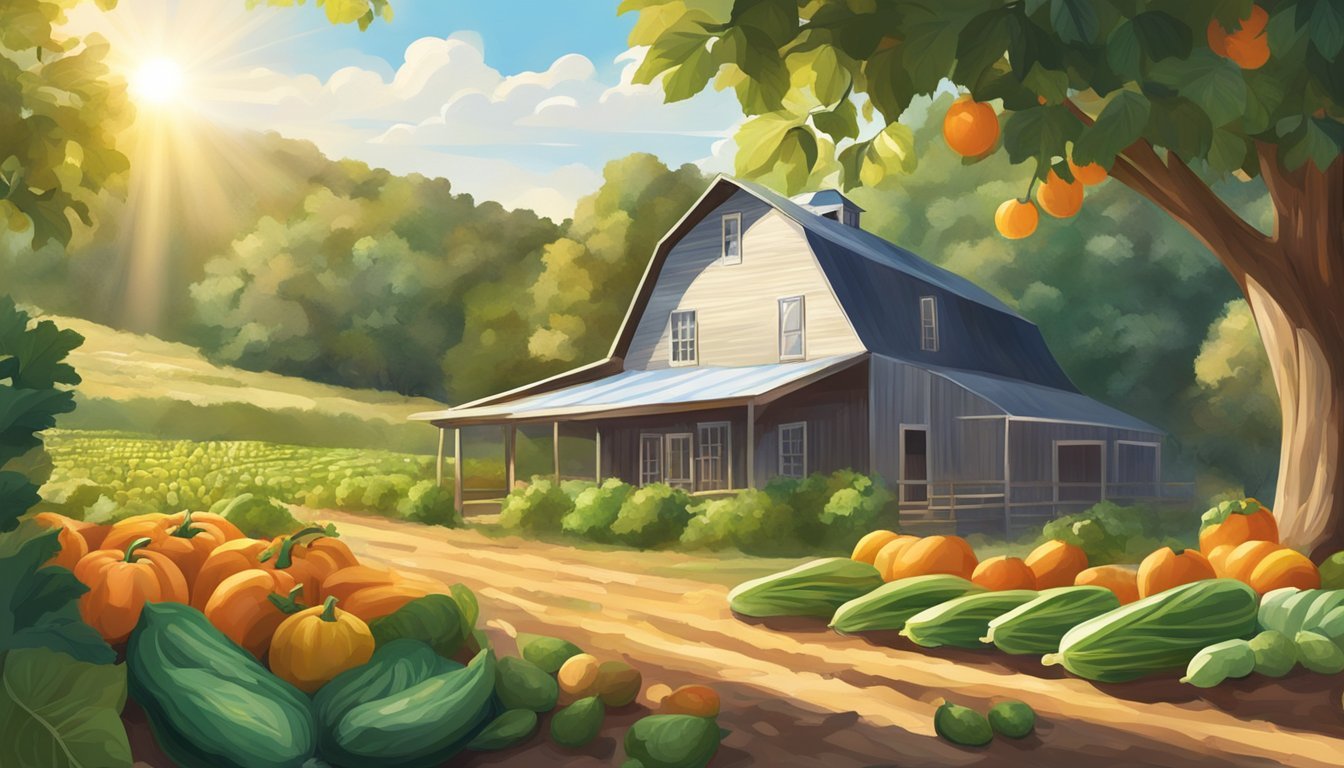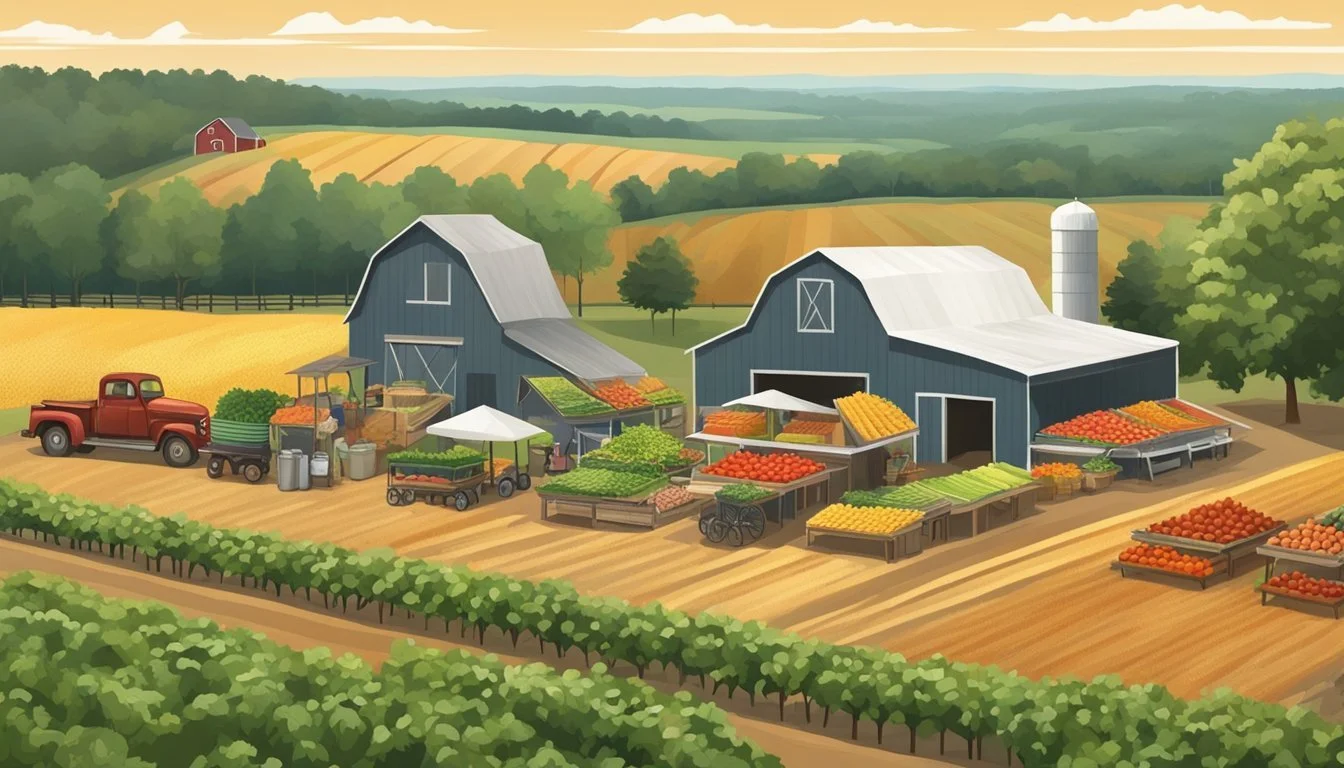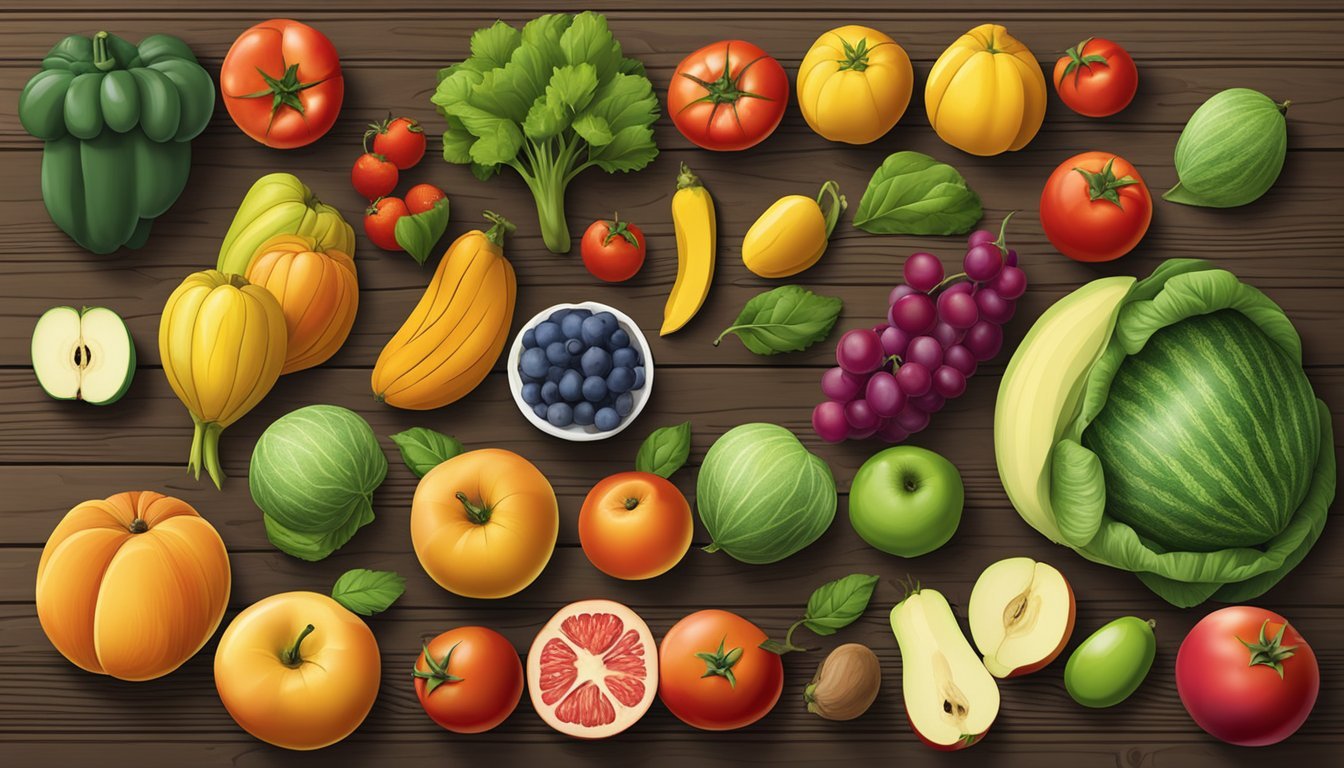Arkansas Seasonal Fruit & Veg Guide
Your Comprehensive Resource
Arkansas, renowned for its diverse agriculture, offers an abundance of fresh, seasonal produce throughout the year. Farm-to-table eating is not just a trend in this state; it's a way of life that celebrates the rich tapestry of fruits and vegetables grown on its soil. By sourcing directly from local farms, Arkansans enjoy a connection to the food on their plates, embracing seasonal cycles that deliver peak flavors and nutrition.
With each season, Arkansas's fertile land yields a new harvest. In spring, the first tender greens and strawberries emerge, signaling the start of the cycle. As the warm summer months roll in, the selection expands to include a colorful array of berries, tomatoes, melons, and much more. The approach of fall brings squash and apples (how long do apples last?)to the forefront, and even the cooler winter days see robust offerings like sweet potatoes and hearty greens. This natural rhythm guides both the agricultural community and the consumers, fostering a sustainable and community-centric food system.
Understanding the seasonal availability of produce not only supports local economies but also ensures that Arkansans are getting the freshest, most flavorful produce possible. The farm-to-table movement in Arkansas thrives on this synergy, allowing both farmers and chefs to showcase the state's agricultural prowess. A guide to seasonal fruits and vegetables becomes an essential tool for anyone looking to explore Arkansas's vibrant local food scene.
What’s in Season in Arkansas Right Now?
Understanding Arkansas' Seasons
Arkansas' diverse climate and growing zones contribute to a robust farm-to-table experience. Understanding the state's seasonal variations is crucial for identifying when various produce is at its peak for harvest.
Climate and Sunlight Factors
The state of Arkansas experiences a temperate climate with four distinct seasons. Climate plays a pivotal role in determining the growing seasons for fruits and vegetables. The amount of sunlight and the occurrence of frost are critical in defining the growing period. Warm summers with ample sunlight help many varieties of produce thrive, while winters can be mild, allowing even some cool-season crops to grow.
Arkansas' Growing Zones
Arkansas is primarily divided into two main growing zones: Zone 6 in the northern part of the state and Zone 8 in the southern region. These growing zones indicate the average minimum winter temperature range, which affects when it's safe to plant and harvest without the risk of frost damage.
Zone 6: Average minimum temperature ranges from -10 to 0°F.
Zone 8: Average minimum temperature ranges from 10 to 20°F.
These zones help gardeners and farmers understand the best times to sow and expect harvests of their crops, in line with the seasonal changes and first or last frost dates.
Seasonal Harvest Calendar
The seasonal harvest calendar provides a timeline of when fruits and vegetables are typically in-season and at their freshest for consumption. Here is a condensed seasonal harvest guide based on Arkansas' typical growing conditions:
Spring: Leafy greens, strawberries, and asparagus (What wine goes well with asparagus?) come into season.
Summer: A bountiful harvest of tomatoes, peaches, berries, cucumbers, peppers, and melons.
Fall: Root vegetables, squash, and apples.
Winter: While growth slows, some greens and cold-tolerant vegetables like kale may be available.
The precise timings can vary depending on specific climate conditions each year, but this calendar serves as a general guide to when consumers can expect to find Arkansas-grown favorites.
Spring Harvest
The Spring harvest in Arkansas ushers in a vibrant selection of fresh produce that's rich in flavor and nutrition. Residents eagerly anticipate the arrival of tender asparagus, a variety of leafy greens, and the first juicy berries of the year.
Early Spring Selections
Asparagus and leafy greens such as spinach and lettuce make their debut during the early Spring months in Arkansas. These vegetables are not only packed with vitamins but also add a fresh, crisp flavor to any meal. Herbs like parsley and cilantro also begin to flourish, offering a fresh boost to springtime dishes.
Late Spring Delights
As the season progresses, the range of available produce expands. Strawberries and blueberries peak in late Spring, bringing with them a burst of sweetness and antioxidants. Moreover, the farming community takes pride in the deep, robust flavors of these fruits, which are much awaited by both local markets and eager home cooks.
Spring Planting Guidelines
The University of Arkansas Extension provides planting guidelines that are invaluable for achieving a successful Spring harvest. Vegetables like tomatoes, cucumbers, and peppers should be planted after the last frost to ensure they receive adequate sunlight and warmth. Following these expert recommendations ensures a diverse and plentiful garden throughout the season.
Summer Abundance
As the summer season peaks, Arkansas's farms offer a bounty of fresh produce. Ranging from sweet, juicy fruits to crisp, flavorful vegetables, the warmer months are the perfect time to enjoy nature's gifts at their prime.
Berries and Stone Fruits
Arkansas summers are prime time for berries and stone fruits. Peaches become available, beginning their peak season in late July, accompanied by an assortment of berries and other stone fruits like nectarines.
Berries: including blueberries, strawberries, and blackberries
Stone Fruits: such as peaches and nectarines
These fruits are not only rich in flavor but also in nutrients, making them ideal for fresh eating, desserts, and preserves.
Melons and Tropical Flavors
Hefty watermelons and sweet cantaloupes typify the essence of summer in Arkansas. These melons thrive in the summer heat and are often harvested at peak ripeness.
Melons: featuring watermelon and cantaloupe
Their hydrating and refreshing qualities make them a perfect choice for hot summer days, whether eaten fresh or in fruit salads.
Vegetables and Greens
Arkansas's soil turns fruitful with a variety of vegetables and greens during summer. Tomatoes, cucumbers, and peppers start to flourish, along with other warm-season favorites like eggplant and okra.
Nightshades: including tomatoes, peppers, and eggplant
Other Vegetables: such as cucumbers and okra
These vegetables serve as staples for salads, grilling, and traditional Southern dishes, proving that summer in Arkansas is not only about fruit but an array of fresh vegetables as well.
Fall Harvest
In Arkansas, the fall harvest brings a bounty of robust flavors and a variety of produce ready to be picked. This time of year marks a transition in the agricultural calendar, where cooler temperatures allow for the growth of certain fruits and vegetables that thrive in the fall months.
Root Vegetables and Squash
Fall is prime time for harvesting a range of root vegetables and squash. The cooler temperatures and shorter days contribute to the sweetening of these earthy crops as they reach peak maturity.
Sweet Potatoes: Sweet and versatile, these are typically ready to be harvested by late September.
Turnips and Radishes: Known for their spicy flavor, they are typically harvested in October.
Squash: Varieties such as butternut and acorn squash offer a sweet, nutty flavor and are usually harvested before the first frost.
Late Harvest Fruits
Arkansas trees yield late-season fruit that are perfect for the fall table.
Apples: Cultivars like Fuji and Pink Lady generally ripen from late September through October.
Pears: Bartlett and other varieties are typically harvested starting in August and can extend into fall.
Muscadines: These native grapes are a southern specialty, with harvest extending into September.
Preparing for Winter
As fall progresses, Arkansas farmers focus on preparing for the winter months.
Pumpkins: Not just for decoration, they are harvested in September and October for their flavor and utility in dishes.
Pruning: Post-harvest, pruning trees and perennials is essential to ensure healthy regrowth for the next year. This is often done after the leaves fall.
Winter Selections
In the cooler months, Arkansas growers focus on cultivating cold-hardy crops and utilizing indoor growing techniques to ensure a steady supply of fresh produce.
Citrus and Hardy Vegetables
During winter, Arkansans can enjoy a bounty of citrus fruits and robust vegetables that tolerate lower temperatures. Oranges are a popular citrus choice, offering a fresh, juicy option during the cooler days. For vegetable gardens, root vegetables like turnips thrive in the cold, along with leafy greens such as kale. Broccoli also stands out as a cold-resistant crop that can handle frosty conditions. Generally, these hardy plants require some direct sunlight but can endure periods of shade, making them well-suited for Arkansas's variable winter weather.
Citrus: Primarily oranges
Hardy Vegetables:
Root Vegetables: Turnips
Greens: Kale
Cruciferous Vegetables: Broccoli
Indoor Growing Tips
For gardeners aiming to extend their growing season, indoor cultivation is a viable solution. Ensuring that plants receive adequate direct sunlight is crucial—supplemental grow lights can compensate for shorter daylight hours. Broccoli and kale, in particular, can benefit from indoor setups, allowing for fresh green harvests even when outdoor conditions are less than ideal. Gardeners should also maintain consistent temperatures and humidity inside to mimic the natural outdoor environment as closely as possible.
Arkansas' Specialty Produce
Arkansas boasts a selection of produce that not only thrives in its unique climate but also brings distinctive flavors to the table. From fruits native to the region to locally celebrated vegetables, the state offers a variety of fresh, farm-to-table options.
Fruits Unique to Arkansas
Arkansas is proud of its native fruits that add a special touch to its agricultural offerings. Prime among them are muscadines, a grape variety that flourishes in Arkansas' warm climate and is known for its deep flavor and versatility in both culinary and wine-making applications. Additionally, Arkansas-grown plums offer a juicy burst of flavor, showcasing the state’s ability to produce fruit that rivals those from traditional fruit-growing states.
Notable Arkansas Fruits:
Muscadines: Typically harvested late summer to fall.
Plums: Enjoyed for their sweet and tart taste, they peak around late summer.
Local Vegetarian Favorites
When it comes to vegetables, Arkansas shines with its locally-grown favorites. Sweet corn and beans are staples in the Arkansan diet, celebrated for their fresh taste and the ability to be incorporated into a multitude of dishes. Sweet corn is especially sought after for its tenderness and sweetness, picked at the peak of ripeness during the summer months. Various types of beans, including snap beans and pinto beans (how long does pinto beans last?), are grown in Arkansas soil, providing a nutritious and versatile component for many meals.
Key Vegetarian Produce:
Sweet Corn: Harvested in summer, known for its sweetness.
Beans: Includes a variety of beans like snap beans, harvested throughout the warm season for optimal taste.
Farm to Table Essentials
When considering the farm to table movement in Arkansas, it's essential to focus on how seasonal, locally sourced produce is brought directly from the farm to the dining table. This journey emphasizes organic produce and the importance of abiding by local permissions and regulations.
Sourcing Locally Grown Produce
Farmers across the state, especially in areas like Little Rock, collaborate with local markets and dining establishments to provide what's in season. For example, summer in Arkansas is the peak time for fresh fruits like peaches, which are sourced from local farms rather than procured from distant locations. This ensures that the produce is at its freshest and most flavorful.
Vegetables: Asparagus (Spring), Beets (Fall)
Fruits: Peaches (Late July - September), Watermelons (Summer)
From Harvest to Your Table
The process from harvest to table is swift, with little time in transit which helps to preserve the produce's quality and nutrient value. Restaurants in Arkansas often use simple yet effective culinary techniques, such as roasting asparagus or preparing beet and apple jam, to enhance the natural flavors of the produce they have carefully sourced from their community.
Asparagus: Roast with olive oil, salt, and pepper at 400°F for 20 minutes.
Jam: Simmer roasted beets and chopped apples to create a delightful seasonal jam.
Permissions and Regulations
To participate in the farm to table movement, one must adhere to state and local permissions and regulations. Arkansas farms intending to supply to local restaurants or sell at farmers' markets must comply with food safety standards and have the proper licensing.
Market Vendors: Required to have permits to sell organic produce
Restaurants: Must ensure fresh produce meets health inspection criteria
In summary, the essentials of farm to table in Arkansas hinge on the collaboration between local farmers, restaurants, and consumers to promote and enjoy seasonal, fresh, and organically grown produce within a regulated framework.
Implementing a Farm to Table Lifestyle
In Arkansas, incorporating a farm-to-table lifestyle involves a commitment to seasonally fresh produce and leveraging community resources for education and updates on harvest times.
Maintaining a Seasonal Kitchen
One starts by understanding the harvesting seasons of various fruits and vegetables in Arkansas. By keeping a seasonal calendar, one can plan meals around what is freshly available. For example, peaches are best from late July to September. A seasonal kitchen also implies preserving the bounty—through canning or freezing—to enjoy Arkansas produce year-round.
Seasonal Produce Calendar:
Season Fruits Vegetables Spring Strawberries, Cherries Lettuce, Spinach Summer Peaches, Watermelon Tomatoes, Bell Peppers Fall Apples, Pears Squash, Pumpkins Winter Citrus Fruits Root Vegetables
The University of Arkansas Extension offers detailed data on when specific crops are in season, ensuring the kitchen stays updated with the freshest options.
Community and Educational Resources
Arkansas encourages a farm-to-table lifestyle through its support of local farms and educational programs. The Center for Arkansas Farms and Food (CAFF) is a notable institution that provides training for future farmers and food entrepreneurs. It emphasizes the importance of community-supported agriculture (CSA) and farm-to-table initiatives.
Farmers markets and CSAs are excellent sources for fresh produce, serving as community hubs where knowledge about seasonal produce is shared. Additionally, many local Arkansas farms offer the opportunity for direct purchasing, which supports the local economy and provides insight into farming practices.
Conclusion
Embracing farm to table practices enhances the culinary scene in Arkansas. Consumers find that seasonal fruits and vegetables not only offer superior flavor but also support local agriculture. As the seasons change, so does the array of produce available at local markets.
Summer sees an abundance of peaches, which reach their peak between late July and September. This is the prime time for Arkansans to enjoy these succulent fruits at their freshest.
Season Produce Highlights Summer Peaches, Tomatoes, Melons Fall Apples, Sweet Potatoes Winter Winter Squash, Greens Spring Strawberries, Asparagus
Local farmers' markets, by adhering to nature's schedule, ensure that produce is harvested at the optimal moment, delivering the healthiest and freshest choices to consumers.
Consumers also benefit nutritionally, as fruits and vegetables harvested during their appropriate seasons are richer in vitamins and minerals. They help sustain the local economy by creating a demand for Arkansas's agricultural products, thereby supporting farmers directly.
Garden planning is key for Arkansans looking to grow their own produce. Vegetables like tomatoes, corn, and root crops require full sunlight and at least six hours of direct exposure daily, which is critical for their growth.
Arkansans strive for a sustainable lifestyle by choosing farm to table. They also contribute to environmental conservation by reducing the carbon footprint associated with long-distance transportation of produce. This positive impact fosters a sense of community and connects consumers to the very soil of Arkansas.









